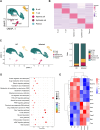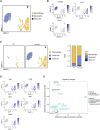Egg-driven immunosuppression and granuloma zonation in Peyer's patches of mice with Schistosoma japonicum infection
- PMID: 40365538
- PMCID: PMC12070193
- DOI: 10.3389/fcimb.2025.1587166
Egg-driven immunosuppression and granuloma zonation in Peyer's patches of mice with Schistosoma japonicum infection
Abstract
Egg granulomas caused by Schistosoma japonicum (S. japonicum) are important causes of morbidity and mortality in schistosomiasis. The intestine plays a crucial role in the complete life cycle of S. japonicum; eggs are transported through the intestine and excreted with feces. During this process, the interaction between the eggs and the intestine can trigger a strong intestinal immune system response and cause inflammation. Eggs in the intestine preferentially accumulate in Peyer's patches (PPs). However, the cellular composition of intestinal granulomas and the impacts of egg deposition on the immune function of PPs remain poorly understood. Using a mouse model of S. japonicum infection, we revealed that the deposition of eggs disrupted the structure of PPs, resulting in immunosuppression. We further characterized the cellular composition of intestinal granulomas, revealing a layered distribution of neutrophils, macrophages, T cells, and B cells, with marked neutrophil accumulation. Single-cell RNA sequencing revealed that egg deposition drives B-cell apoptosis, T-cell exhaustion, and activation of fibrotic pathways in myeloid cells, collectively impairing PP function. In conclusion, the layered cellular architecture of intestinal granulomas in PPs suggests a unique immune microenvironment of egg-driven immunosuppression and fibrotic remodeling, and the identification of fibrotic pathways in myeloid cells provides a potential therapeutic target to alleviate fibrosis in patients with S. japonicum infection.
Keywords: Peyer’s patch; Schistosoma japonicum; fibrosis; granuloma; immunosuppression.
Copyright © 2025 Li, Wu, Cao, Yao, Miao, Zhuang, Xiang, Zhong, Liu, Chen, Dai, Dai, Xu and Zhang.
Conflict of interest statement
The authors declare that the research was conducted in the absence of any commercial or financial relationships that could be construed as potential conflicts of interest.
Figures








References
MeSH terms
LinkOut - more resources
Full Text Sources
Miscellaneous

